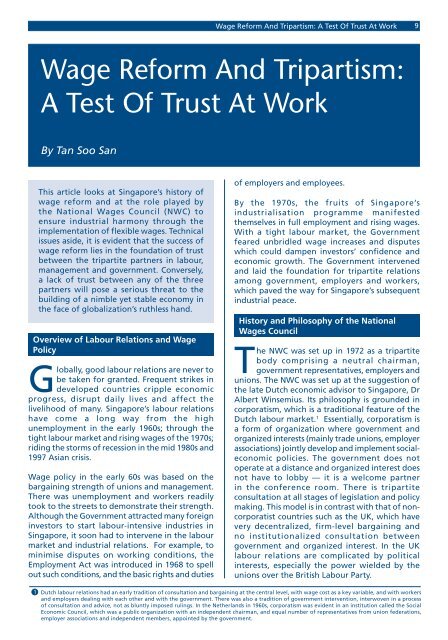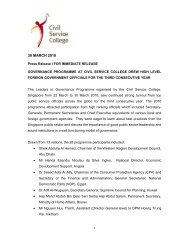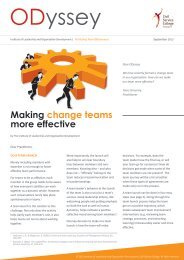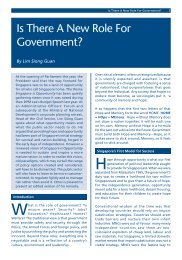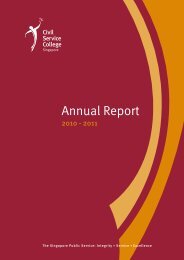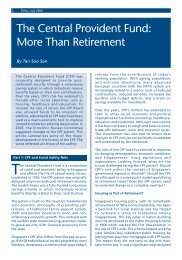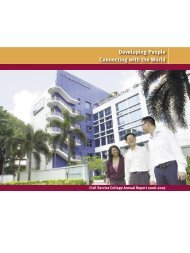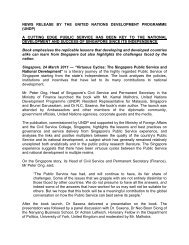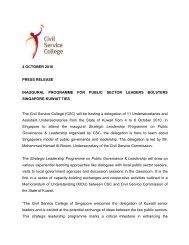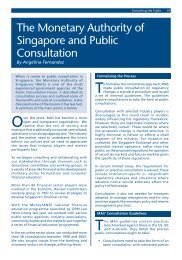Wage Reform & Tripartism : A Test of Trust At Work - Civil Service ...
Wage Reform & Tripartism : A Test of Trust At Work - Civil Service ...
Wage Reform & Tripartism : A Test of Trust At Work - Civil Service ...
You also want an ePaper? Increase the reach of your titles
YUMPU automatically turns print PDFs into web optimized ePapers that Google loves.
<strong>Wage</strong> <strong>Reform</strong> And <strong>Tripartism</strong>: A <strong>Test</strong> Of <strong>Trust</strong> <strong>At</strong> <strong>Work</strong>9<strong>Wage</strong> <strong>Reform</strong> And <strong>Tripartism</strong>:A <strong>Test</strong> Of <strong>Trust</strong> <strong>At</strong> <strong>Work</strong>By Tan Soo SanThis article looks at Singapore’s history <strong>of</strong>wage reform and at the role played bythe National <strong>Wage</strong>s Council (NWC) toensure industrial harmony through theimplementation <strong>of</strong> flexible wages. Technicalissues aside, it is evident that the success <strong>of</strong>wage reform lies in the foundation <strong>of</strong> trustbetween the tripartite partners in labour,management and government. Conversely,a lack <strong>of</strong> trust between any <strong>of</strong> the threepartners will pose a serious threat to thebuilding <strong>of</strong> a nimble yet stable economy inthe face <strong>of</strong> globalization’s ruthless hand.Overview <strong>of</strong> Labour Relations and <strong>Wage</strong>PolicyGlobally, good labour relations are never tobe taken for granted. Frequent strikes indeveloped countries cripple economicprogress, disrupt daily lives and affect thelivelihood <strong>of</strong> many. Singapore’s labour relationshave come a long way from the highunemployment in the early 1960s; through thetight labour market and rising wages <strong>of</strong> the 1970s;riding the storms <strong>of</strong> recession in the mid 1980s and1997 Asian crisis.<strong>Wage</strong> policy in the early 60s was based on thebargaining strength <strong>of</strong> unions and management.There was unemployment and workers readilytook to the streets to demonstrate their strength.Although the Government attracted many foreigninvestors to start labour-intensive industries inSingapore, it soon had to intervene in the labourmarket and industrial relations. For example, tominimise disputes on working conditions, theEmployment Act was introduced in 1968 to spellout such conditions, and the basic rights and duties<strong>of</strong> employers and employees.By the 1970s, the fruits <strong>of</strong> Singapore’sindustrialisation programme manifestedthemselves in full employment and rising wages.With a tight labour market, the Governmentfeared unbridled wage increases and disputeswhich could dampen investors’ confidence andeconomic growth. The Government intervenedand laid the foundation for tripartite relationsamong government, employers and workers,which paved the way for Singapore’s subsequentindustrial peace.History and Philosophy <strong>of</strong> the National<strong>Wage</strong>s CouncilThe NWC was set up in 1972 as a tripartitebody comprising a neutral chairman,government representatives, employers andunions. The NWC was set up at the suggestion <strong>of</strong>the late Dutch economic advisor to Singapore, DrAlbert Winsemius. Its philosophy is grounded incorporatism, which is a traditional feature <strong>of</strong> theDutch labour market. 1 Essentially, corporatism isa form <strong>of</strong> organization where government andorganized interests (mainly trade unions, employerassociations) jointly develop and implement socialeconomicpolicies. The government does notoperate at a distance and organized interest doesnot have to lobby — it is a welcome partnerin the conference room. There is tripartiteconsultation at all stages <strong>of</strong> legislation and policymaking. This model is in contrast with that <strong>of</strong> noncorporatistcountries such as the UK, which havevery decentralized, firm-level bargaining andno institutionalized consultation betweengovernment and organized interest. In the UKlabour relations are complicated by politicalinterests, especially the power wielded by theunions over the British Labour Party.1Dutch labour relations had an early tradition <strong>of</strong> consultation and bargaining at the central level, with wage cost as a key variable, and with workersand employers dealing with each other and with the government. There was also a tradition <strong>of</strong> government intervention, interwoven in a process<strong>of</strong> consultation and advice, not as bluntly imposed rulings. In the Netherlands in 1960s, corporatism was evident in an institution called the SocialEconomic Council, which was a public organization with an independent chairman, and equal number <strong>of</strong> representatives from union federations,employer associations and independent members, appointed by the government.
10 Ethos, November 2004The first Singapore NWC chairman (whose tenurelasted from 1972-2001) was academic economistPr<strong>of</strong> Lim Chong Yah. The representatives were topleaders from labour, management associations,permanent secretaries <strong>of</strong> ministries and chairmen<strong>of</strong> statutory boards. The Council is essentially anegotiating body at the national level for nationalguidelines on wages, bonus and benefits. Thegovernment representatives played an integrativethird party role given their ready access tostatistical information.Annually, the NWC reviews wage rates inrelation to the economy’s performance. It thenrecommends appropriate wage adjustments andsubmits them to the Government for approval,which has the power to accept, reject or modifythe recommendations. Over the years the NWC’srecommendations have gained credibility andauthority as they have all been accepted by thegovernment.The key to the NWC’s success is the involvement<strong>of</strong> and frank exchange between employers andunions, with the Government performingan advisory role in providing information aboutthe economy, labour market and growthprospects. The NWC undertakes a holisticreview <strong>of</strong> Singapore’s economic indicatorssuch as productivity growth, internationalcompetitiveness, unemployment, inflation and theglobal economy.NWC recommendations are meant as guidelinesfor negotiation between employers and theunions. They have provided a bedrock forindustrial peace and ensured conducive conditionsfor Singapore’s continued growth, prosperity andemployment. Two major NWC contributions arethe wage restraint policy in the 1986 recession tohelp companies regain competitiveness and wagereform by the introduction <strong>of</strong> a flexible wagesystem.NWC Recommendations 1972-19881972-78 Moderate wage increaseDuring the 1973-74 world recession, the NWCrecommended moderate wage increases asSingapore’s aim was to attract foreign investments.When global inflation affected Singapore, theNWC recommended high wage increase in 1974.Between 1975 and 1978, the NWC recommendedmoderate wage increase as there was slowergrowth with the economy recovering from the oilcrisis.1979-84 High wage increaseThe early part <strong>of</strong> this period was characterized bylabour shortage and low productivity. In line withthe government’s push to restructure the economythrough more high value-add and higher-skilledindustries, the NWC pushed up wages. This wouldencourage more efficient use <strong>of</strong> scarce manpowerthrough automation. In 1980 and 1981, the NWCencouraged wage increase to be based onindividual performance so as to enhance labourproductivity. For the rest <strong>of</strong> the period, highwage increases continued. By 1985, Singapore’slabour costs were substantially higher than itscompetitors, with productivity growth laggingbehind real earnings.1985-87 <strong>Wage</strong> restraintBy the second half <strong>of</strong> 1985, Singapore hadslipped into its first post-independence recession.GDP suffered its first negative growth since 1964.Unemployment hit 6.1% and about 95,000 jobswere lost. The Government took a 15% cut in CPFrate to cut wage costs. To reinforce this counterrecessionarystrategy, the NWC recommendedsevere wage restraint. Unions and employersaccepted the call. Increase in average earningsslowed from 7.9% in 1985 to 0.8% in 1986. Thesecost-cutting measures in 1986/7 brought down unitlabour costs in manufacturing by more than 15%and the economy recovered.1988-present Qualitative wage adjustmentsThe 1986 recession revealed the rigidities <strong>of</strong> thewage system and spurred the Government torethink its competitiveness strategies, through thesetting up <strong>of</strong> the Economic Committee in 1986.NWC’s quantitative guidelines in the past were notsuitable for such turbulent times and had in factadded wage rigidity to the system. In charting anew direction for the economy, the Governmenthad to find measures to add flexibility into thewage system without creating instability throughdirect negotiation that was not anchored by NWCquantitative benchmarks. Otherwise, the industrialpeace that had been built over the decades wouldbe at stake.Evolution <strong>of</strong> <strong>Wage</strong> <strong>Reform</strong>The Economic Committee (EC) in 1986 had aSub-Committee on Manpower that studiedthe rigidity in Singapore’s wage system andthe need for wage reform, including the need fora fine-tuning <strong>of</strong> NWC’s role and responsibilities.
<strong>Wage</strong> <strong>Reform</strong> And <strong>Tripartism</strong>: A <strong>Test</strong> Of <strong>Trust</strong> <strong>At</strong> <strong>Work</strong>13“The Flexible <strong>Wage</strong> System will continue to be animportant tool for us to use to respond quickly to thechanging conditions.”storms, such as the economic uncertainties arisingfrom the September-11 attacks, war in Iraq andSARS. It allowed the <strong>Civil</strong> <strong>Service</strong> to make rapidand timely adjustments to <strong>Civil</strong> <strong>Service</strong> pay inresponse to the crises. In November 2001, inresponse to the economic uncertainty, Ministersand senior civil servants again led by example,taking wage cuts <strong>of</strong> up to 10%. In July 2003, afurther 10% wage cut was taken <strong>of</strong>f the grossmonthly wages <strong>of</strong> Ministers and senior civilservants. In November 2003, in view <strong>of</strong> decliningprivate sector salaries as shown by our benchmarkanalysis, the <strong>Civil</strong> <strong>Service</strong> re-based the AVC ratefrom 3 /4 month to 1 /2 month. Bearing in mind amonthly salary cut would more directly affect thedaily livelihood <strong>of</strong> <strong>of</strong>ficers, cuts were made to theAVC. As wage levels vary with the economy andlabour conditions, the FWS will continue to be animportant tool for us to use to respond quickly tothe changing conditions.How Far Have We Come With <strong>Wage</strong>Restructuring?SARs necessitated many emergency measuresto cope with the sudden plunge <strong>of</strong> businessesand job loss. <strong>Work</strong>ers have understood andwitnessed the real threat to their employmentand some companies were forced to make wagesvariable. The unions, particularly the Food, Drinksand Allied <strong>Work</strong>ers Union (FDAWU) supportedthe moves to cut costs such as compulsory nopay-leave,shorter work weeks etc. <strong>Wage</strong> cutswere also taken by management. Due to thehotels’ close cooperation with the unions, moralewas kept up and trust was preserved betweenworkers and employers. Therefore hotel workerswere not retrenched and the efforts paid<strong>of</strong>f when business returned and hotels couldramp up their services quickly and economically.From these experiences, hotels have seen thebenefits <strong>of</strong> restructuring and are committed toimplementing flexible wages.This is however not the case across the board.While most companies recognize the advantages<strong>of</strong> a more flexible and competitive wage system,till today many companies have not taken the stepbecause <strong>of</strong> the lack <strong>of</strong> expertise and resources.The call for a more flexible and competitive wagesystem was reiterated in the reports <strong>of</strong> theEconomic Review Committee (ERC) and TripartiteTaskforce on <strong>Wage</strong> Restructuring (formed in July2003 by NWC recommendation) which submittedits report in Jan 2004. The latter was formed bygovernment, SNEF and NTUC to push for widerimplementation <strong>of</strong> wage restructuring. TheCompetitive Base <strong>Wage</strong> System (CBWS) model wasrecommended. This was essentially based on fivewage principles, namely sustainable growth,competitiveness, flexibility, motivation andstability. These are similar to the principles behindthe FWS with the following new principles:• Sustainable growth: The wage structureshould support business sustainability,investment, job creation and betteropportunities for all.• Motivation: Management should incentiviseemployees to give their best and add greatervalue. Management should also take the leadin wage restructuring in bad times.There is a need to extend the efforts to moresectors <strong>of</strong> the economy as well as to small andmedium-sized companies. The ERC recommendeda 30% variable component (20% AVC and 10%MVC) for rank-and-file employees, 30-40% formiddle management and no less than 40% for topmanagement. The Taskforce also recommendedthat the AVC should reward employees fortheir individual performance as well as theircontribution to company performance. The MVCshould be linked to company performance and byvirtue <strong>of</strong> it being paid out monthly, allowscompanies to adjust wages when faced with shorttermunexpected economic shocks without havingto wait until the end <strong>of</strong> the year.
14 Ethos, November 2004The civil service has been taking the lead in wagereform, but it remains to be seen if the rest <strong>of</strong> thesectors will follow suit. Why is implementation astumbling block for many?Implementation IssuesDuring the keynote speech at theNational Tripartite Conference on <strong>Wage</strong>Restructuring on 30 Jan 2004, then DPMLee Hsien Loong described the implementationissue as follows:“While the arguments for wage restructuringare compelling, actually doing it is not easy.For companies it means designing workableschemes, and persuading workers <strong>of</strong> theirmerits in order to bring them on board. Forunions it means participating in changingarrangements which workers have becomeused to, and taking a broader and longer termview <strong>of</strong> workers’ interest. For workers, itmeans accepting more variability and lesscertainty, in exchange for more job security andan upside when the outcome justifies that. Forolder workers particularly, moving away fromseniority-based wages means accepting painfulbut necessary adjustments to improve theiremployment prospects.Further, wage restructuring cannot be doneby the Government alone. We cannot simplypass a law or publish a formula which appliesto every company. . .Commitment by all parties, and especiallyfrom the top, is essential.”Some Mindsets Must Change<strong>Reform</strong> is painful. There is an inevitableconflict <strong>of</strong> interests among the variousstakeholders. Good relations betweenworkers and management and union leaders candetermine the success or failure <strong>of</strong> wagerestructuring efforts. Some fundamental mindsetsare a hindrance.First, one must be convinced that wagerestructuring and reform are not wage cuts.<strong>Work</strong>ers might not trust the company to give theman upside when times turn better, and see thedesignation <strong>of</strong> MVC as a cut in monthly salary.<strong>Work</strong>ers must understand that companies need tomake adequate pr<strong>of</strong>it, and that iron rice bowlsare gone forever. They must also accept that it isbetter to have variable wages to allow thecompany flexibility in tough times than to riskbeing retrenched. Time, dialogue, communicationand information sharing are needed for workersto buy into the concept.Second, some think the job <strong>of</strong> wage restructuringis that <strong>of</strong> the HR manager. But it is the CEOthat must take the lead. It is a strategic issue <strong>of</strong>business strategy and people-managementand not simply an administrative or numbersgame. The employees must trust that there isa good system <strong>of</strong> Key Performance Indicators orthat the appraisal system is linked to company’sperformance and individual effort.Third, timing is an issue. Some employers fear thatwage restructuring will worsen the morale <strong>of</strong> acompany. Others feel that while the economy ison the mend, there is no real urgency for wagereform. They would rather not have the hassle<strong>of</strong> tinkering with wages when they need tocompete more aggressively for workers. Otherscontinue to think that they can cut wages orretrench workers when the need arises hence thereis no need for fundamental reform. There mustalso be agreement between management andunions on when MVC can be cut. Naturally unionswould not want the management to dictate whenan MVC cut is necessary.Fourth, there must be willingness for theemployers to share information with their workerson the company’s performance, challenges andfuture plans. They need to build trust andconfidence with union leaders to share concernsand exchange views.Finally, some SMEs or family-owned businessessimply do not have the expertise, resources orproper HR system to put wage restructuring inplace.Challenges for the FutureTo thrust implementation forward, theTripartite Taskforce undertook a threeprongedstrategy. First, a “first wave” <strong>of</strong>successful examples <strong>of</strong> wage restructuring wascreated to provide”a catalyst and encouragecompanies to follow their footsteps. HR expertsand <strong>of</strong>ficials from NTUC, SNEF and MOM workedclosely with selected companies to kick-start theprocess. Second, it helped interested companiesbuild up HR capabilities by providing training toHR consultants to build up the capacity <strong>of</strong> the HR
<strong>Wage</strong> <strong>Reform</strong> And <strong>Tripartism</strong>: A <strong>Test</strong> Of <strong>Trust</strong> <strong>At</strong> <strong>Work</strong>15“The NWC allows us to speak with one clear voice toeach other, as well as to investors. This is a uniqueand precious advantage. ”industry in the medium term. Thirdly, it marketedthe national wage restructuring effort throughsmaller platforms such as industry associations andsectoral working groups within industry so as togenerate confidence and greater buy-in.The Government, through the work <strong>of</strong> theTripartite Taskforce, worked closely with 4 sectors(hotel, electronics, chemicals and land transport)to lead them to implement wage restructuring.The Government hopes that the rest <strong>of</strong> thecompanies and unions in other industries willachieve similar results. Then-DPM Lee said thathe hoped by next year, over 50% <strong>of</strong> the totalworkforce in large companies and 40% <strong>of</strong> the totalworkforce in SMEs would come under someflexible wage system.Today’s knowledge-based economy poses newchallenges for wage reform. A rise in part-timeand contractual work could lead to a move awayfrom unionized labour and question the raisond’etre <strong>of</strong> unions. In uncertain economic timesinfluenced by the ups and downs <strong>of</strong> security andterrorist threats, it might also be harder forcompanies and employees to forge a commonunderstanding <strong>of</strong> and definition <strong>of</strong> “good and badeconomic times” and the need to reduce variablecomponents to save jobs. <strong>Trust</strong> might not havetime to develop a long term footing if workersare forced to move from firm to firm when jobsbecome more mobile. Another challenge is ourageing society which calls for equitable treatment<strong>of</strong> both young and old workers without creatingdisincentives for work or compromise reward forperformance.instrument for maintaining tripartite consensusand unity to serve as a foundation to build animble and progressive economy. Then-DPM Leesummed up the value <strong>of</strong> the NWC’s role:“The NWC allows us to speak with one clearvoice to each other, as well as to investors.This is a unique and precious advantage. Veryfew other countries can have the unions,employers and the Government seatedharmoniously in one room discussing how torestructure wages and develop a flexiblelabour market.”(Then-DPM Lee Hsien Loong’s keynote addressat the National Tripartite Conference on <strong>Wage</strong>Restructuring on 30 Jan 2004)To preserve this unique advantage, the foundation<strong>of</strong> trust cannot be shaken. Apart from unceasinggovernment efforts, unions have a critical role toplay in enabling the continuation <strong>of</strong> open andconstructive dialogue between the managementand workers.Conclusion<strong>Wage</strong> restructuring is one <strong>of</strong> the keyimplementation challenges faced bySingapore in order to prepare for futureeconomic challenges. The NWC remains a key


